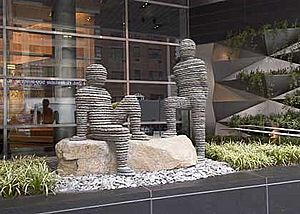Boaz Vaadia facts for kids
Boaz Vaadia (born November 13, 1951 – died February 25, 2017) was a famous Israeli-American artist. He was known for his sculptures made from stone and later bronze. Vaadia lived in New York City from 1975. His art showed the strong connection between people and nature. He often said, "I work with nature as an equal partner." His sculptures are found in many important museums around the world. These include The Metropolitan Museum of Art in New York and The Israel Museum in Jerusalem. Vaadia passed away at age 65.
Contents
Boaz Vaadia's Early Life and Art Journey
Boaz Vaadia grew up on a small farm in Gat Rimon, Israel. His parents taught him to love and respect the earth. From a young age, he knew he wanted to be a sculptor. At 14, he went to art school at Avni Institute of Art and Design in Jaffa. He even pretended to be older to get in!
In 1969, Vaadia joined the Israeli army. During his time off, he helped restore old stonework in Jerusalem. He learned ancient stone-handling skills from local stonemasons. He also learned how tools for carving stone were made.
Discovering His Unique Style in New York
Vaadia moved to New York City in 1975. He studied at Pratt Institute. Soon after, he found the materials that would define his art. He discovered old bluestone pavement and slate roofing tiles. These were being thrown away as the city was rebuilt.
He realized that bluestone naturally breaks into layers. At first, he tried to force the stone into different shapes. But he learned to let the stone's natural layers guide his work. This was a big moment for him. He said he "surrendered to it." This way of working copied how layers form in nature.
Sculpting with Stone and Gravity
From 1985, Vaadia started making sculptures of people. He used the same idea of stacking layers of stone. He kept the sculptures stable using the force of gravity. He would chip away at each stone layer with a hammer and chisel. This made the sculptures look like they were formed by nature.
Vaadia understood that his materials had limits. He made sure his sculptures could stand on their own. They were held together only by gravity. (Later, they were bolted for safety). This meant his figures often had calm, strong poses. They reminded people of ancient statues like the Easter Island moai.
Expanding His Art with Figures and Animals
Later, Vaadia started making sculptures with two or three figures. These pieces showed a strong connection between the figures. They honored everyday people. In 1987, he also began making bronze versions of his stone sculptures. This allowed him to create new kinds of art.
In 1989, he found ancient boulders during street repairs near his studio. He saved them and used them in his art. For many years, he explored layered figures. He made sculptures of families and even domesticated animals. In 2002, he started making portraits. He captured people's looks while keeping his unique layered style.
Vaadia believed that "Man came from the earth and in death returns to it." He saw stone as the "bone structure of the earth." His art often made people think about our connection to nature.
Where to See Boaz Vaadia's Art
Many museums and collections around the world have Boaz Vaadia's sculptures. Here are some of them:
- The Baker Museum, Naples, FL
- Bass Museum of Art, Miami Beach, FL
- Flint Institute of Arts, Flint, MI
- Hakone Open Air Museum, Japan
- The Israel Museum, Jerusalem, Israel
- The Jewish Museum, New York, NY
- The Metropolitan Museum of Art, New York, NY
- The Museum of Modern Art, San Francisco, CA
- Norton Museum of Art, West Palm Beach, FL
- Open Museum at Tefen, Israel
- Point Leo Sculpture Park, Victoria, Australia
- Racine Art Museum, Racine, WI
- Ravinia Sculpture Park, Chicago, IL
- Tel Aviv Museum of Art, Israel
- Time Warner Center, New York
- Tokyo Metropolitan Teien Museum, Japan
- Vero Beach Museum of Art, Vero Beach, FL
Awards and Recognition
Boaz Vaadia received many awards and grants for his art.
- In 1975, he got a grant from the America-Israel Cultural Foundation. This helped him move to New York.
- In 1976, he received a Beeckmann Scholarship.
- In 1977, he had an artistic residency in Palisades Interstate Park, NY. He created a sculpture for the Appalachian trail.
- He received grants from the Committee for the Visual Arts (1985) and the Ariana Foundation For the Arts (1986).
- In 1988, he received a grant from the National Endowment for the Arts.
- In 1992, he traveled to Japan to receive the Utsukushi-ga-hara Open Air Museum Award.
- In 2012, he received the Aviv Award for Artistic Achievement.
- In 2014, he was given the Russian Heritage Month Award. This was for his work in promoting Bukharian heritage through art.
Boaz Vaadia's Art Market Journey
When Boaz Vaadia moved to SoHo, New York City, in 1975, he met Ivan Karp. Karp was a famous art dealer who became Vaadia's main dealer. Vaadia had his first big solo show in 1976. It featured art inspired by African altars and ancient tools.
In 1986, Vaadia had his first show of figurative sculptures. The entire show sold out in just three hours! Ivan Karp said he had "never seen anything like that in his entire life." Today, Vaadia's art is shown by several galleries. These include Jim Kempner Fine Art in New York and Connaught Brown in London.
His Passing
Boaz Vaadia passed away on February 25, 2017. He was married to Kim Vaadia and had two daughters, Rebecca and Sara. He continued to work on his art almost until the very end. His last finished piece was a large stone relief sculpture. His family plans to turn his studio into a museum.



